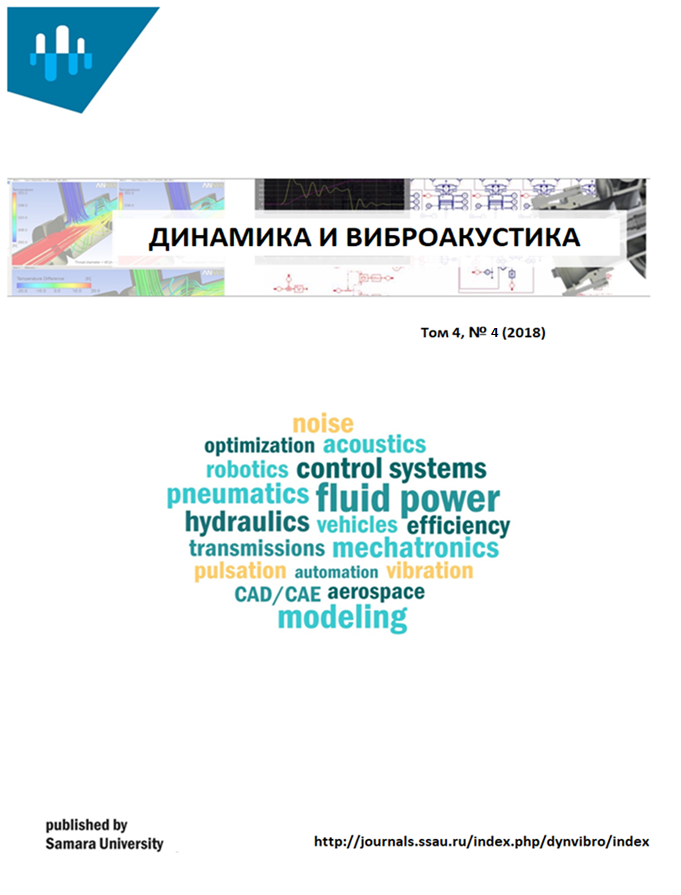Researches of processes of generation of sound waves by film thermophones
- Authors: Vasilev B.1, Legusha F.1, Razrezova K.1
-
Affiliations:
- State marine technical university of Saint-Petersburg
- Issue: Vol 4, No 4 (2018): 21.12.2018
- Pages: 27-36
- Section: Articles
- Published: 21.12.2018
- URL: https://dynvibro.ru/dynvibro/article/view/6666
- DOI: https://doi.org/10.18287/2409-4579-2018-4-4-27-36
- ID: 6666
Cite item
Full Text
Abstract
This work is of a survey nature based on the results of studies of the processes of sound emission in gases and liquids by thermo-acoustic film sources - thermophones. The purpose of the article is to show the features of the calculation, operation and determination of the main acoustic characteristics of thermophones, ways to increase the efficiency of their radiation and directions of possible practical application.
The basic relations and formulas are presented, the calculation of which is confirmed by the experimental results carried out, analyzed ways to excite and improve the effectiveness of thermophones.
Film thermophones of various shapes without a thermally insulating substrate have uniform, reproducible acoustic characteristics, which can be predicted by calculation, knowing the thermal-physical constants of the materials used for the construction of thermophones. As the active elements of guns are used for a thin film formed by the vacuum deposition of metals on surfaces of bearing plates made of polymer materials. When passing through the active element of an alternating electric current with a frequency f, an acoustic wave is emitted at a doubled frequency of 2f. Film thermophone are the only sources of sound emitting surface which meets the definition of a piston radiator. Thermopane work in the frequency range from 1.0 to 150 kHz.
A promising direction of research is the use of thermophones as sources of radiation of sound in a liquid medium. The results of a study of the radiation of a film thermophone in two liquids (distilled water and kerosene) are presented. Compared to radiation to air, radiation to kerosene, for example, is about 20 dB higher.
About the authors
Boris Vasilev
State marine technical university of Saint-Petersburg
Email: bp_vas@mail.ru
candidate of technical science, professor of department of physics
Russian FederationFedor Legusha
State marine technical university of Saint-Petersburg
Email: legusha@smtu.ru
doctor of phys.-math. science, head of the department of physics
Russian FederationKseniya Razrezova
State marine technical university of Saint-Petersburg
Author for correspondence.
Email: kv_neveselova@mail.ru
candidate of phys.-math. science, junior researcher of research part
Russian FederationReferences
- Beranek, L. (1952), Acoustic measurements, IL, Мoscow, Russia, pp. 626
- Arnold H.D. and Crandall, I.B. (1917), The Thermophone as a Precision Source of Sound, Phys. Rev., pp. 22–38.
- Wente, E. C. (1922), The thermophone, Phys. Rev., pp. 333-345.
- Landau L. D. and Lifshits, E. M. (1986), “Theoretical physics. Hydrodynamics”, Nauka, vol. 6, pp. 736.
- Legusha, F. F. and Neveselova, K. V. “Radiation of sound by a surface whose temperature varies according to a harmonic law”, Proceedings of the XXV session of RAO. Physical acoustics. M.: GEOS, 2011, pp. 83-86.
- Vasiliev B. P., Legusha F.F., Neveselova K.V. Radiation of sound by a plane conducting surface under the influence of alternating currnt, Proceedings of the XXV session of RAO. Physical acoustics, GEOS, 2012, Moscow, Russia, pp. 74-77.
- Legusha, F. F. and Neveselova, K. V. (2012), Investigation of sound radiation processes by a thermophone Investigation radiation processes by a thermophone of sound, MSTU N.E. Bauman, Moscow, Russia, pp. 43-47.
- Vasiliev, B. P., Legusha, F. F. and Neveselova K. V. “Thermoacoustic emitters of low-frequency sound and their application in acoustics”, Proceedings of the XXVII session of RAO, ded. memory of scientists-acousticians "Krylovsky SSC" A.V. Smolyakova and V.I. Popkov, 2014, St. Petersburg, Russia.
- Vasiliev, B. P. and Neveselova, K. V. (2015), “Thermoacoustic sources of a sound on the basis of flat wire structures”, Marin intellectual technologies, vol. 1, no. 4, issue 30, pp. 65-71.
- Shinoda, H., Nakajima, T., Ueno, K. and Koshida, N. (1999), “Thermally induced ultrasonic emission from porous silicon”, Nature, vol. 400, pp. 853-855.
- Niskanen, A. O., Hassel, J., Gronberg, L. and Helisto, P. (2009), “Suspended metal wire array as a thermoacoustic sound source”. J. Appl. Phys. Lett., vol. 95, Issue 16, p. 163102-1-163102-3.
- Chitnis, G., Kim, A., Song, S.H., Jessop, A.M. and Bolton, J.S. (2012), A thermophone on porous polymeric substrate, Birck and NCN Publications, P. 1160.
- Legusha F.F. and Neveselova, K.V. (2014), “Broadband thermoacoustic sources of a sound – thermophone”, Marin intellectual technologies, vol. 1, no. 3, issue 25, pp. 71-77.
- Legusha, F.F. and Neveselova, K.V. (2015), “Experimental investigations on modern thermophones”, Marin intellectual technologies, vol. 1, no. 4, issue 30, pp. 60-65.
- Vasiliev, B.P., Legusha, F.F. and Razrezova, K.V. (2016), “Experimental investigations on film thermophones”, Marin intellectual technologies, vol. 1, no. 4, issue 34, pp. 118-123.
- Vasiliev, B.P., Legusha, F.F., Razrezova, K.V. and Chizhov, G.V. (2017), “Active elements of film sources of sound-thermophones”, 13th International Conference on Films and Coatings, J. Phys.: Conf. Ser. 857 012051, vol. 857, St. Petersburg, Russia, 18-20 April, 2017.
- Neveselova, K.V. (2014), “Calculation of time dependent temperature amplitude of the thermophone active element”, Marin intellectual technologies, vol. 1, no. 4 issue 26, pp. 110-115.
- Rzhevkin, S.N. (1960), Course of lectures on the theory of sound, Pabl. МSU, Moscow, Russia, 338 p.
- Skudrzyk, E. (1976), “The foundation of acoustics”, World, Мoscow, Russia, vol. 2, 548 p.
- Aliev, A.E., Lima, M.D., Fang, S. and Baughman, R.H. (2010), “Underwater Sound Generation Using Carbon Nanotube Projectors”, Nano Lett., no. 10, issue 7, pp. 2374-2380.
- Legusha, F.F., Pugachev, S.I., Razrezova, K.V. and Starobinec, I.M. (2018), Thermoacoustic effect in the liquid medium, Nestor-History, St. Petersburg, Russia.
- Vasiliev, B.P., Legusha, F.F., Pugachev, S.I., Razrezova, K.V., and Starobinets, I.M. (2018), “Generation of sound waves by film thermophone into a liquid”, MIT, St. Petersburg, Russia, vol. 1, no. 2, issue 40, p. 104-108.
Supplementary files







